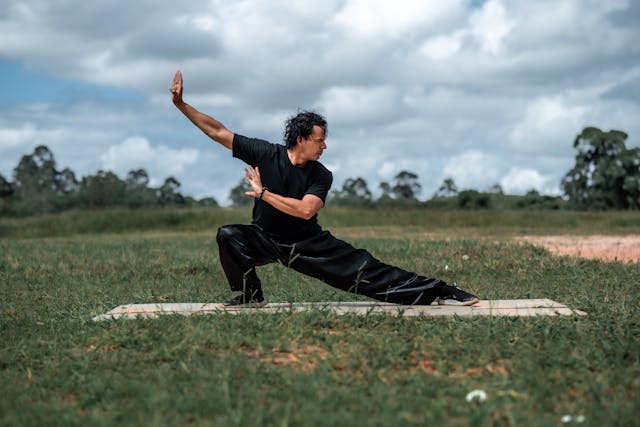Achieving true wellness means nurturing both body and mind. Science confirms that physical and mental health are deeply interconnected—what benefits one often boosts the other. By incorporating evidence-based habits into daily life, we can enhance our well-being, build resilience, and lead more fulfilling lives. Let’s explore the most effective strategies, their scientific foundations, and who has successfully used them to thrive.

1. Exercise: A Natural Mood and Energy Booster
Physical activity is not just about aesthetics—it’s fundamental to both physical and mental well-being. Regular exercise releases endorphins, dopamine, and serotonin, neurotransmitters that enhance mood, reduce stress, and improve cognitive function (Ratey, 2008). Additionally, it strengthens the cardiovascular system, improves lung capacity, supports metabolic health, and reduces the risk of chronic conditions such as diabetes, hypertension, and osteoporosis.
Studies show that just 30 minutes of moderate exercise five times a week can significantly reduce symptoms of depression and anxiety (Blumenthal et al., 2007). Resistance training, yoga, and aerobic exercises each offer distinct benefits, from improved muscular strength to better flexibility and cardiovascular endurance. Elite athletes and everyday individuals alike use movement as a tool for mental clarity and emotional regulation. Additionally, group activities, such as team sports or community fitness classes, can enhance social bonds, further improving mental resilience.

2. Nutrition: Fueling Mind and Body
The gut-brain axis plays a crucial role in mental health. Diets rich in omega-3 fatty acids, antioxidants, and fiber support brain function and reduce inflammation, which is linked to depression and cognitive decline (Gomez-Pinilla, 2008). Nutrients such as vitamin B12, folate, and magnesium are essential for neurotransmitter production and stress management.
The Mediterranean diet, for example, is associated with lower risks of heart disease, diabetes, and depression. Populations in Blue Zones—regions known for longevity—rely on nutrient-dense, plant-based foods to maintain overall health (Buettner, 2012). Incorporating fermented foods like yogurt, kimchi, and kombucha can enhance gut microbiome diversity, leading to improved mood and immunity. Proper hydration also plays a crucial role, as even mild dehydration can impair cognitive function and energy levels

3. Sleep: The Ultimate Reset Button
Quality sleep is vital for both mental clarity and physical recovery. During deep sleep, the brain clears out toxins through the glymphatic system, reducing the risk of neurodegenerative diseases like Alzheimer’s (Xie et al., 2013). Additionally, sleep regulates hormone levels, including cortisol and melatonin, improving stress resilience, immune function, and metabolic balance.
The CDC recommends at least seven hours of sleep per night for adults. Sleep hygiene practices, such as maintaining a consistent sleep schedule, reducing blue light exposure before bedtime, and creating a relaxing nighttime routine, can improve sleep quality. Successful individuals, from athletes to business leaders, prioritize rest to maintain peak performance. Sleep deprivation, on the other hand, is linked to weight gain, memory issues, and increased risk of cardiovascular disease.

4. Mindfulness and Meditation: Training the Brain for Resilience
Mindfulness and meditation have been used for thousands of years in Buddhist traditions and are now supported by modern neuroscience. Studies show that meditation reduces amygdala activity—the part of the brain responsible for stress responses—while enhancing prefrontal cortex function, which governs rational thinking and emotional regulation (Davidson et al., 2003).
Long-term practitioners, including monks and CEOs, report lower anxiety, improved focus, and better decision-making. Even as little as 10 minutes of daily mindfulness practice can enhance mental resilience and overall well-being. Techniques such as guided visualization, progressive muscle relaxation, and loving-kindness meditation (Metta) offer unique approaches to fostering inner peace. Apps like Headspace and Calm have made mindfulness accessible to millions worldwide.

5. Social Connections: The Power of Community
Humans are inherently social beings. Strong relationships are linked to lower levels of stress hormones and improved cardiovascular health (Holt-Lunstad et al., 2010). Loneliness, on the other hand, is associated with increased risks of depression, heart disease, and even premature death.
In cultures like those in Okinawa, Japan, and Sardinia, Italy, close-knit communities contribute to increased happiness and longevity. Prioritizing social bonds—whether through family, friendships, or community groups—enhances both physical and emotional well-being. Regular social interactions have been shown to boost immune function and cognitive longevity. Volunteering and engaging in acts of kindness also elevate oxytocin levels, further strengthening emotional health.

6. Nature Exposure: The Science of Green Therapy
Spending time in nature has profound health benefits. Studies indicate that forest bathing (shinrin-yoku) lowers cortisol levels, reduces blood pressure, and enhances immune function (Li, 2010). Green spaces also improve mood and cognitive function, making nature therapy a powerful antidote to modern stressors.
In countries like Finland and Japan, government programs encourage nature exposure to boost public health. Incorporating outdoor activities, whether through hiking, gardening, or simply walking in a park, can significantly enhance well-being. Urban green spaces and community gardens provide an accessible way for city dwellers to reap the benefits of nature.

7. Breathwork: Harnessing the Nervous System
Breathwork techniques such as diaphragmatic breathing, pranayama, and the Wim Hof method have been shown to regulate the autonomic nervous system, reducing stress and inflammation (Zaccaro et al., 2018). Deep, controlled breathing activates the parasympathetic nervous system, promoting relaxation and improved oxygenation.
High-performance athletes, yogis, and even military personnel use breathwork to enhance focus, endurance, and resilience. Breath-focused practices have also been integrated into therapeutic settings for managing PTSD, anxiety, and chronic pain conditions.

8. Gratitude and Positive Psychology: Shaping a Healthier Mindset
Practicing gratitude rewires the brain for positivity by increasing neural pathways associated with happiness and emotional resilience (Emmons & McCullough, 2003). Studies suggest that keeping a gratitude journal can improve sleep, reduce stress, and enhance overall life satisfaction.
The concept of positive psychology, pioneered by Dr. Martin Seligman, emphasizes strengths and well-being rather than focusing solely on mental illness. Incorporating gratitude and optimism into daily routines can create lasting improvements in mental and physical health. Acts of gratitude also promote stronger relationships and increased empathy, reinforcing social bonds.

Conclusion: Small Changes, Big Impact
Science confirms that true wellness involves a synergy between physical health and mental well-being. By incorporating movement, nutrition, rest, mindfulness, social bonds, nature exposure, breathwork, and gratitude into daily life, we can cultivate resilience, longevity, and happiness. Start small, stay consistent, and enjoy the profound benefits of a balanced mind and body.
Love Life x
References:
- Blumenthal, J. A., et al. (2007). “Exercise and pharmacotherapy in the treatment of major depressive disorder.” Psychosomatic Medicine.
- Buettner, D. (2012). The Blue Zones: 9 Lessons for Living Longer from the People Who’ve Lived the Longest.
- Davidson, R. J., et al. (2003). “Alterations in brain and immune function produced by mindfulness meditation.” Psychosomatic Medicine.
- Emmons, R. A., & McCullough, M. E. (2003). “Counting blessings versus burdens: An experimental investigation of gratitude and subjective well-being in daily life.” Journal of Personality and Social Psychology.
- Gomez-Pinilla, F. (2008). “Brain foods: the effects of nutrients on brain function.” Nature Reviews Neuroscience.
- Holt-Lunstad, J., et al. (2010). “Social relationships and mortality risk: A meta-analytic review.” PLOS Medicine.
- Li, Q. (2010). “Effect of forest bathing trips on human immune function.” Environmental Health and Preventive Medicine.
- Ratey, J. J. (2008). Spark: The Revolutionary New Science of Exercise and the Brain.
- Xie, L., et al. (2013). “Sleep drives metabolite clearance from the adult brain.” Science.
- Zaccaro, A., et al. (2018). “How breath-control can change your life: A systematic review on psychophysiological correlates of slow breathing.” Frontiers in Human Neuroscience.
